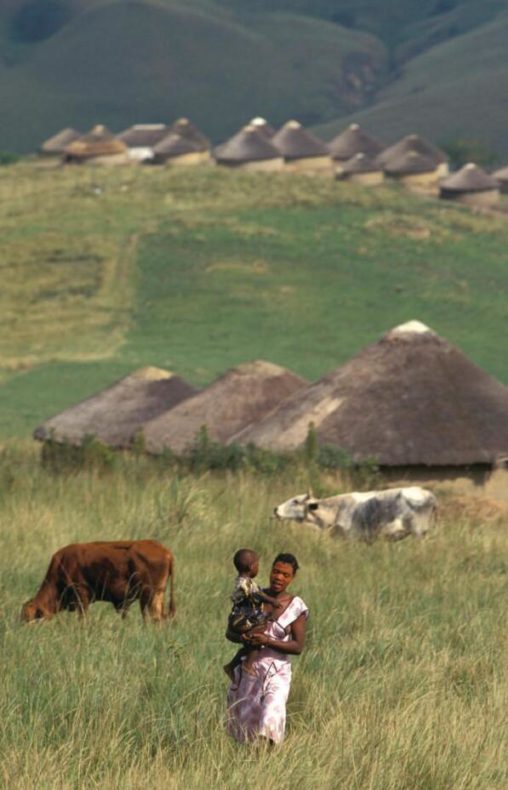The world famous Victoria Falls on the Zambezi are arguably the main attraction in Zambia. But there is still numerous other highlights such as the Kafue National Park in the west and the Luangwa National Park in the east of the country. Safari tours with guides are offered here, you can stay in lodges and camps. A combination of safari, adventure and fishing offer river tours on the Zambezi River. Visitors can experience the absolute thrill of oneLeap from the 111 m high Victoria Falls Bridge, one of the highest bridges used for bungee jumping in the world.
In addition to the numerous national parks and protected areas, a large part of Zambia is characterized by powerful and smaller rivers and waterfalls. The fascinating spectacle of the rushing waterfalls, where massive amounts of water plunge into the depths at breathtaking speed and under deafening roar, are impressive for every visitor. Many tourists come to Zambia to admire one or more of these natural spectacles.
The Zambezi is the most important river in Zambia, but there are also spectacular waterfalls on other rivers. If you want to see several huge waterfalls, you should go to the Kolungwishi River. The Lumange, Chimpepe, Kabweluma and the Kundabwik waterfall plunge here. There are also some waterfalls on the tributaries of the Kolungwishi. At the Kolombo Falls and the Lunzua Falls, the water masses plummet over 200 meters. These waterfalls are located on Lake Tanganyika. There are also a few smaller waterfalls in Zambia, which ripple down more comfortably and much more quietly. The Chusa Falls, for example, belong to this category.
Zambia lies on a plateau covered by savannas, which reaches up to 1,000 to 1,400 meters above sea level, many valleys are very steep and deep. The climate in Zambia is tropical, but the high temperatures are noticeably reduced by the altitude.
Area: 752,618 km² (land: 743,398 km², water: 9,220 km²)
Population: 13.9 million people (July 2011, COUNTRYAAH.COM). 98.7% of the population are black Africans who belong to 72 different Bantu peoples. The largest peoples of Zambia are: Bemba, Luba, Nyanja (including Chichewa, Nsenga and Ngoni), Tonga (including Lenje, Soli and Ila), Lunda, Luvale, Kaonde and Lozi. In addition, small minorities of Europeans (1.1%) and others such as Asians (0.2%).
Population density: 18 people per square kilometer
Population growth: 3.062% per year (2011, CIA)
Capital: Lusaka (1.35 million residents, 2007).
Here is a detailed list of the 45 largest cities in Zambia.
Form of government: Zambia has been a presidential republic since 1964 and is represented in the Commonwealth. The constitution dates from 1991, the last constitutional change was made in 1996. The unicameral parliament consists of the National Assembly with 158 members (150 directly elected, 8 are appointed by the President) and the President of the Parliament (159 mandates). Both the president and members of parliament are elected directly every 5 years. Zambia has been from Great Britain since October 24, 1964independently.
Administrative division: 9 provinces: Central, Copperbelt, Eastern, Luapula, Lusaka, Northern, North-Western, Southern and Western.
Head of government and Head of state: President Michael Sata, since September 23, 2011
Highest point: unnamed point in the Mafinga Hills, 2,301 m
Lowest point: Zambezi River, 329 m
Language: the official language in Zambia is English. In addition, more than 70 different Bantu languages are spoken in the country (including Nyanja, Bemba, Tonga, Chokwe, Lozi, Luvale and Lunda).
Religion: 50 to 70% Christians, 24 to 49% Muslims and 1% followers of natural religions.
Local time: CET + 1 h
In Zambia there is no change between summer and winter time.
The time difference to Central Europe is +1 h in winter and 0 h in summer
Telephone area code: 00260 or +260
Internet ID:.zm
Mains voltage: 220 V, 50 Hz
Geography
The Republic of Zambia, located in southern Central Africa, is almost divided into two due to a bulge in the Zairian territory. It borders Angola in the west, the Democratic Republic of the Congo in the north, Tanzania in the northeast, Malawi in the east, Mozambique in the southeast, Zimbabwe and Botswana in the south and the Caprivi peak. The Zambezi originates in northern Zambia and forms Zambia’s southern border with Namibia, Botswana and Zimbabwe. The Victoria Falls at the southern end of the artificial Lake Kariba are one of the most amazing natural wonders in Africa, if not the world.
Here you can find a detailed topographic map of Zambia.
Most of Zambia consists of relatively low relief plateaus between 1,000 and 1,400 m high. However, these plateaus are very different. In the north there is the huge crater floor of the Bangweulubassins, which is bordered by the plateau of the Copperbelt in the south, the long Luapula valley in the west, the Mporokosobergen in the north and the Muchinga Mountains in the east. Along this mountain range runs from north to south the Luangwa Valley, which is bordered in the north by foothills of the southern Tanzanian highlands and in the east by the Mafinga Hills, which merge into the central highlands of Malawi and in which the highest regional office, the Mafinga, is located with a height of 2,300 m. The west of Zambia with the source area of the Zambezi is a flat oneKalahari sand area that slopes gently towards the south. Dramatic reliefs can only be found along the Zambezi cliff.
Population in Zambia
This map of population distribution in Zambia was created by the Worldmapper team. Densely populated areas appear bloated, the area of sparsely populated areas is reduced. The shape of the grid has been preserved; an underlying map with the original geographical extent helps interpret the map. The distorted map should help to present abstract statistical information clearly.




